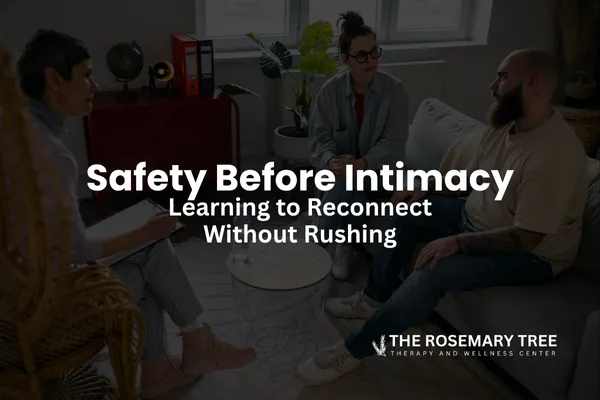
Safety Before Intimacy: Learning to Reconnect Without Rushing
When You Want to Feel Close Again But Don’t Know How
After betrayal or long-standing conflict, many couples crave closeness but fear it at the same time. You might miss your partner’s touch but flinch when they reach for you. You might want to talk, but every word feels heavy with history.
This push and pull is normal. The body wants comfort, but the nervous system remembers pain. Rebuilding intimacy begins with one simple truth: safety must come first.
Why Rushing Intimacy Can Reopen Old Wounds
When safety has been broken, intimacy can’t be forced or scheduled. Attempts to “go back to normal” too soon often backfire, leaving both partners more disconnected.
Physical or emotional closeness that happens before the body feels ready can trigger feelings of anxiety, guilt, or even panic. This does not mean the relationship is doomed—it means healing is still in progress.
The goal is not to recreate what was lost, but to build something new: connection that feels safe, slow, and mutual.
Emotional Intimacy Before Physical Intimacy
In the aftermath of betrayal, emotional intimacy needs to be rebuilt before physical closeness can feel genuine again. That begins with small moments of emotional risk met with care instead of defensiveness.
Start with:
Listening without fixing or reacting
Sharing feelings instead of facts
Expressing gratitude for small acts of kindness
Asking permission before initiating touch or difficult conversations
Every moment of emotional honesty strengthens the sense of safety your body needs to relax again.
Understanding the Body’s Role in Intimacy
When trust has been broken, the body often stays in a protective stance. This is not a choice—it’s a survival mechanism. The nervous system associates closeness with potential danger.
Healing means helping the body learn that closeness can once again feel secure. This takes time and patience. In therapy, couples often practice grounding and mindfulness exercises to reconnect through calm awareness, not pressure.
Some examples include:
Sitting quietly together and focusing on breathing
Holding hands while maintaining gentle eye contact
Naming sensations of warmth, relaxation, or comfort when they appear
Stopping immediately if either person feels tense or uneasy
These small, safe experiences teach the nervous system that intimacy can exist without fear.
Communication That Creates Safety
The way you communicate about closeness matters as much as the actions themselves. Honest conversations help prevent misunderstanding and rebuild trust.
Try using language like:
“I want to feel close to you, but I also want to take it slow.”
“Can we pause if I start feeling anxious?”
“I appreciate you being patient with me while I rebuild trust.”
This kind of communication invites connection instead of pressure. It reminds both partners that safety is a shared goal, not a demand.
How Therapy Intensives Support This Process
Our Accelerated Deep-Work Therapy Intensives are designed to help couples navigate this delicate stage of recovery.
In these extended sessions, couples work closely with licensed clinicians to:
Rebuild trust and safety through guided dialogue
Learn body-based tools to manage anxiety and tension
Explore new ways of communicating about boundaries and needs
Create a shared plan for gradual reconnection
Address triggers that appear when intimacy begins to return
This slower, structured process allows both partners to stay connected without pushing past emotional readiness.
When the Desire to Rush Comes From Fear
Sometimes one partner wants to move quickly because they fear the relationship will fade if closeness does not return. Others pull away because every attempt feels like reopening the wound.
Neither reaction is wrong—they are both protective. What matters is learning to honor those differences. Intimacy grows when both partners agree to move at the speed of trust.
What Healthy Reconnection Looks Like
Healing intimacy does not mean constant closeness or forced affection. It looks like calm, mutual engagement where both people feel emotionally safe. Over time, couples begin to notice:
Conversations feel easier and more open
Physical closeness feels natural, not forced
Laughter and warmth return to everyday moments
Trust begins to replace tension
These are signs that safety has returned, and connection is becoming real again.
Final Thoughts
Rebuilding intimacy is not about perfection. It is about patience, presence, and care. Safety gives intimacy the room to breathe, and over time, that safety becomes the foundation for connection that lasts.
If you and your partner are struggling to reconnect or feel ready to rebuild closeness in a safe, guided way, we would love to help. You can reach out to us here, and our team will connect with you to talk about what this process could look like. There is no pressure, only a space to begin healing together.
